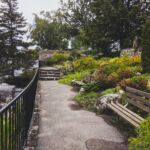Hardscape is the term used to describe materials in a landscape made of hard elements like walls, patios, walkways, fences, decks, gazebos, and immediate pool surroundings. Hardscapes use elements like pavers, natural stones, and bricks to achieve your dream landscape. These materials are used to enhance your landscape and to provide structure and practicality by building retaining walls, walkways, and patios. Choosing the wrong types of pavers for example can make your yard look like it is in disarray.
Choosing hardscape material that you want to improve your yard can be quite challenging. Hardscape materials must blend in with the aesthetics of your home, but they should not be too loud or too mellow. Picking the wrong material, will not only affect the aesthetics of the home and yard, but it can also need high maintenance. Consideration should also be given to the location and to the general climate of your property, and materials should be able to withstand your local weather and not require constant repairs or replacement.
If you’re wanting to build a hardscape to complement your landscape design, you’ll first want to make sure you choose the right materials for the job. Remember, the material that works best for your patio might not be the right material for your pool deck.
Patios
When designing your patio area, paving stones are a great solution. They are available in many different colors, sizes, and pavers can be combined into different patterns creating a strong visual effect. Pavers are a great option if you want to start small and add to it down the road, because more pavers can be purchased and laid down next to the first phase without any significant visual difference.
There are a variety of pavers available for sale, including natural stone and concrete pavers. You will defiantly want to research the different pavers available to figure out which option is best for your specific project. For example, concrete pavers cost less than brick or natural stone pavers. This is because the cost of raw materials to manufacture concrete is significantly less than brick or natural stone, and installation is typically easier, meaning a lower installation cost.


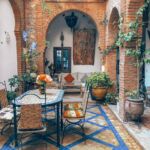
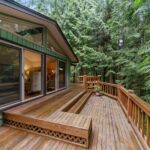

Pools and Lounge Areas
Most people do not realize a pool is a type of hardscape. Pools are made up of a series of specialized materials layered together to form a waterproof barrier the area around your pool. This structure is also known as the pool deck or pool surrounding.
Pool decks typically have furniture or other larger items on it. The pool deck should be both flat and stable, which makes poured concrete or pavers a great choice. Because the material is going to be around the pool, it should be subject to special considerations, including how slippery it can become when wet or how hot it becomes under the sun.
Another thing to consider with a pool deck is how easy it is to either remove or repair. Things always happen and if you need to repair the pool deck, the material used for the repair has a direct impact on the time and cost to you. If you have a pool deck made of poured concrete slab, getting to the plumbing means tearing out the slab and repaving the concrete when the job is finished. If pavers are used, it is quite easy for a contractor to remove the specific paver, or section of pavers to do their work. Then when they are done, simply replace the paver.
If your backyard is big enough, you may consider adding a secondary lounge area. These areas are the perfect place to place for a couple comfy chairs around an outdoor fire pit to enjoy evenings outside. Functionally, these areas are the same as patios, so you’ll want materials that can create the same flat, stable flooring. If you wanting the secondary lounge area to house your outdoor fire pit, you will want to use a material that is non-combustible.




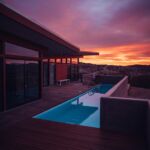
Walkways
When considering paths, you must first decide if this path is a actual walking on path, or just for decoration. If you want to use your walking path, and you don’t want your yard stepped on or worn down, you will want to incorporating dedicated walkways to your landscape. Walkways not only protect your landscaping, but they are easy to keep clean, even as the seasons change and your greenery begins to shed its leaves.
Walkways are created from brick, pavers, wood, or even smaller loose stones like river rocks or pebbles. Whichever material you choose to use, think about incorporating borders around it, like a raised border if your design calls for it. This will help people stay on the designated beaten path.
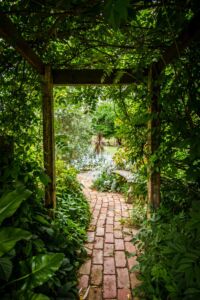
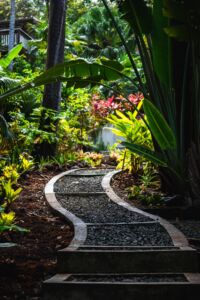
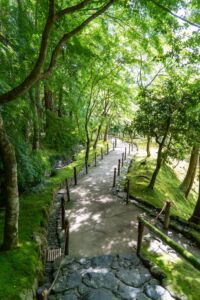
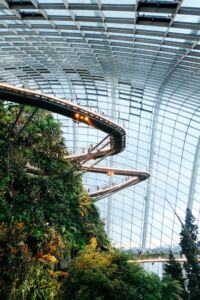


Retaining Wall
Your landscape might need a retaining wall. This could be because a retaining wall is to prevent soil erosion, or it could be used to provide dimensions to your landscape. Depending on the reason why you are building a retaining wall, and the complexity of the project, you may want to consulting with an expert landscape architect. If the wall is at the bottom of a natural or manmade slope or is intended to prevent soil erosion, you will also want take drainage into consideration when choosing the material.
Retaining walls are made from a variety of materials, including concrete, interlocking concrete blocks, stone or even timbers. The specific material will depend on your preference, budget, and skill level. Poured concrete tends to be the cheapest per square foot, but often requires a professional to install. Concrete blocks are popular amongst DIYers, as they are relatively easy to install and can be purchased at big box stores such as Lowes or Home Depot. The most aesthetically pleasing is the natural stone retaining wall, although also probably the most expensive.
Hopefully this will help you in determining which hardscapes you want to incorporate into your landscape. Your hardscape design is only limited by your imagination and the space that is available to you. Regardless of what type of hardscape you choose to build, you will want to pay close attention to the demands that are placed on your hardscape materials and how certain materials will hold up under use.




